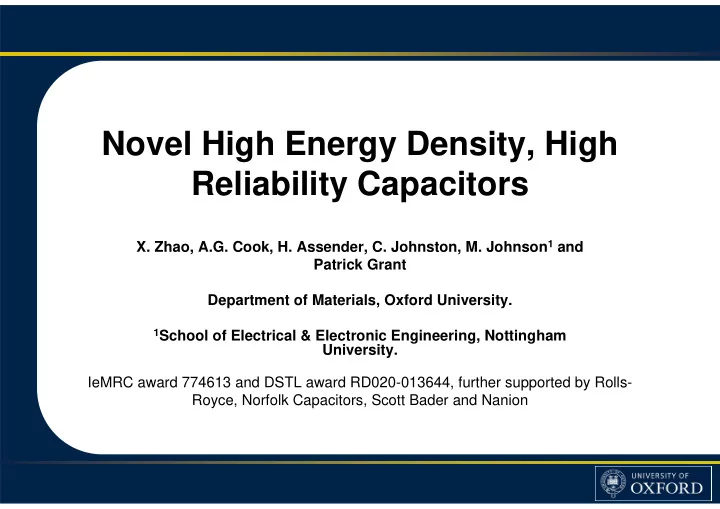

Novel High Energy Density, High Reliability Capacitors X. Zhao, A.G. Cook, H. Assender, C. Johnston, M. Johnson 1 and Patrick Grant Department of Materials, Oxford University. 1 School of Electrical & Electronic Engineering, Nottingham University. IeMRC award 774613 and DSTL award RD020-013644, further supported by Rolls- Royce, Norfolk Capacitors, Scott Bader and Nanion
Outline The more electric airframe Power capacitors Nanocomposite dielectrics Progress Conclusions and future directions
More electric aircraft Features Electrical starting Electro-hydraulic actuators / Loads Electro-mechanical Lights Anti-ice actuators LE flaps Electrical anti-ice 250kW generator Modified cabin APU generator Cabin ECS Elevators Lights environmental system services compressor Loads Loads Rudder Simplified engine-airframe Loads Galleys interface Avionics ECS Lights compressor power Load converter Gear Deleting 250kW Generator generator Ailerons Fuel Power Three major hydraulic pump TE flaps control Spoilers Load systems centre Ram-air turbine Loads Transmission Transmission& Cabin-air bleeds Distribution Pneumatic anti-ice
More electric aircraft For a 200 passenger B767-type aircraft : 10% reduction in aircraft empty weight 13% reduction in required engine thrust 9% reduction in fuel burn significant reduction in emissions [NASA] “Global electrical optimisation is the only way to achieve meaningful improvements in the total airframe package” M.J. Provost, Advanced Propulsion Systems Design, Rolls-Royce, Proc Int. Conf. IEE Power Electronics, Bath, 2002
Power capacitors Increased electrical power generation – 1MW Increased power conditioning Current high value capacitors based on electrolytics or polymer films Heavy (~40% of converter), temperature limited (~70°C), catastrophic failure modes ⇒ the “weakest link” Combining a high permittivity nanoscale ceramic powder with a high temperature polymer film to produce a high performance dielectric nanocomposite
Nanocomposite dielectric materials Ceramic particles in polymers Add nanoparticles to increase dielectric constant to 30-50 ( C α ε ) But Thin films ( C α 1/ t ) Do not undermine breakdown strength ( u α E 2 ) Do not compromise processability into large areas Do not increase density more than necessary Properties up to 200ºC Develop a scaleable manufacturing technology
Objectives To investigate the manufacturability of polymer based nanocomposite films for power capacitor applications at the laboratory and near industrial scale. To undertake performance and reliability testing and to relate performance to processing and microstructural features.
Manufacturing technology Spray deposition Web coating Lab-scale Lab-scale Proof of concept Proof of concept Intermediate scale Near industrial scale Industrial collaborators
Manufacturing technology Compressed air Hypodermic Monomer needle(s) delivery Sputter Roll-to-roll E-beam cathode Pre- heated table X-Y manipulator Syringe pumps with linear drives nano suspensions Rotating drum Evaporation
Spray deposition Compressed air Compressed air TPGDA/BaTiO 3 /MEK:EtOH suspension TPGDA/BaTiO 3 /MEK:EtOH suspension Spray nozzle Spray nozzle Syringe Syringe Atomized droplet spray Atomized droplet spray Hypodermic Hypodermic Syringe pump Syringe pump needle needle Pre-metallized Pre-metallized glass substrate glass substrate Heated plate moving Heated plate moving in x-y in x-y y y x x
Acrylate-BaTiO 3 films SEM micrograph of PTPGDA-30vol%BaTiO 3 film at an accelerating voltage of 2.0 kV.
Acrylate-BaTiO 3 films Dielectric constant and dissipation factor (tan δ ) of spray deposited PTPGDA- BaTiO 3 nano-composites at 25 ° C as a function of frequency for various volume fractions of BaTiO 3 .
Acrylate-BaTiO 3 films Comparison of experimental data and theoretical predictions of ε for PTPGDA-BaTiO 3 nanocomposites Spray deposition of polymer nanocomposite films for dielectric applications, X. Zhao et al , Mat. Sci. Eng. B. in the press.
Perfluoro alkoxy CNT films SEM micrographs of as-grown aligned arrays of (a) 100 µ m x 50nm multi-wall carbon nanotubes (MWNT-1), (b) 500 µ m x 50nm (MWNT-2), and (c) and (d) after sonication.
PFA-CNT films Dependence of dielectric permittivity and AC conductivity of: (a) PFA-MWNT-1 films, and (b) PFA-MWNT-2 films on MWNT volume fraction at 10kHz. Insets show best of AC conductivity to percolation theory.
Manufacturing technology Spray deposition Web coating Lab-scale Lab-scale Proof of concept Proof of concept Intermediate scale Near industrial scale Industrial collaborators
Web coating – lab unit up and running Evaporation E-beam Rotating source Melamine + drum TiO 2 -np film? Monomer Sputter delivery cathode
Conclusions Nanoparticle-polymer films New process route Exciting properties Scale up CNT-polymer films Reproduced (exceeded?) best results from literature Shows “platform” nature of process Other industrial uses Mini web coater First good results obtained but need to show reproducibility Migrate to large web coater in the next year IeMRC investment effectively geared with other funds
Recommend
More recommend